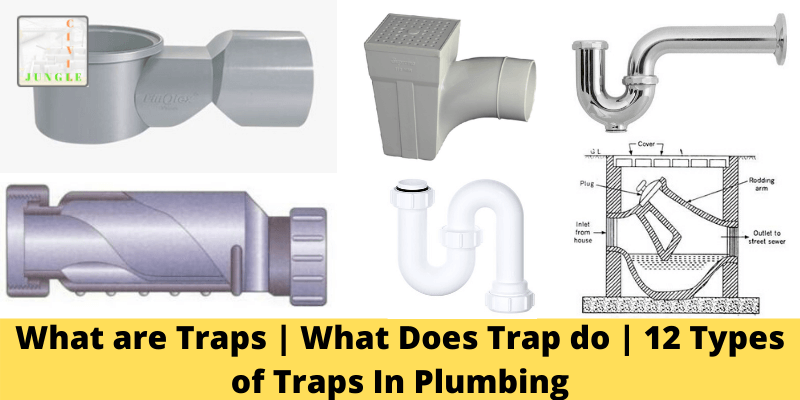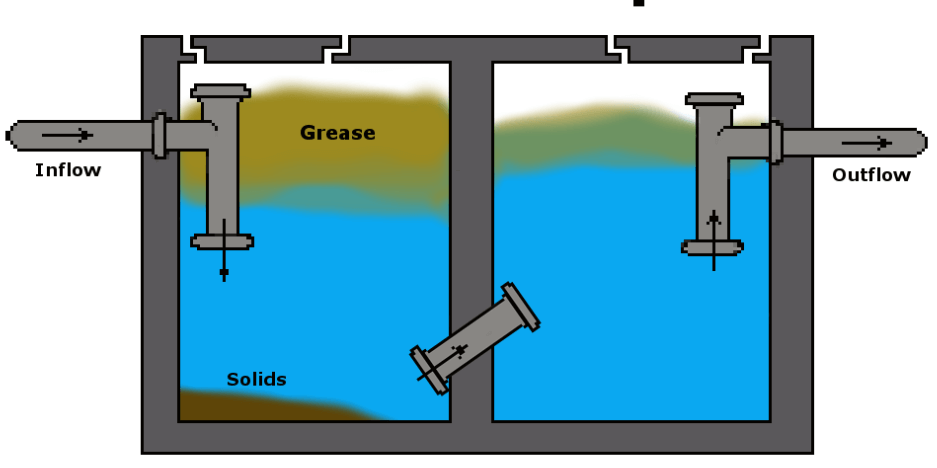
What are Traps In Plumbing?
As the name suggests, traps simply trap the water and sewer gas. A trap is a plumbing device used to prevent smell, bacteria, also insects entering your home.
Every water-using appliance or fitting has a drain line to flow out the waste-water, and you must have a trap in the pipe that seals the drain.
The seal is important to keep the environment fresh as it will prevent sewer gasses from entering the building. You can see traps equipped with varied plumbing fixtures like sinks, bathtubs, toilets, and washbasin.
With the help of several connections, you can install a trap which is usually located within a plumbing fixture.
Traps are designed in such a way that it retains some amount of water which indeed creates a seal for foul gasses and stops them from entering the property.
What Does Trap do?
Traps are designed to prevent sewer odors from entering the home through the plumbing fixtures. The seal in the trap is provided by the waste-water.
Every time we use a fixture, we flush out the water that is forming the trap seal and replace it with new water.
Traps are carefully engineered systems. They are designed to be self-scouring so that they don’t collect debris yet retain water to form a seal. The velocity with which waste moves through a trap is important.
If it’s too fast, the water that is supposed to remain in the trap will be siphoned down the drain. If it’s too slow, solids will tend to get deposited in the bottom of the trap.
It’s easy to see why people shouldn’t try making their own traps out of piping and fittings.
Types of Traps in Plumbing
Different types of traps in plumbing are as follows.
- Floor Trap or Nahni Trap.
- Gully Trap.
- P Trap.
- Q Trap.
- S Trap.
- Intercepting Trap.
- Bottle Trap.
- Grease Trap.
- Drum Trap.
- Running Trap.
- Straight-Through Trap.
- Low-Level Bath Trap.
- Bell Trap.
- Building Trap.
1. Floor Trap:

This trap is provided on the floor to collect wastewater from the bathroom, sink, shower, and washbasin, etc.
These are available in UPVC or cast iron material and have removable grating on the top of the trap. The minimum depth of the water seal should be 50 mm, 75mm, 110mm.
2. Gully Trap:

Gully Trap, also known as G.T. A Gully Trap, is provided outside the building before connecting it to the external sewerage line. It also collects wastewater from the kitchen sink, washbasins, bath, and wash area.
The heavy cast iron gully traps shall not be less than 7.25 KG in weight with cover weighing not less than 4.53 kg, and frame not less than 2.72 kg, and total depth shall not be less than 30 cm (1 ft) also available UPVC gully trap As per figure.
3. P Trap:

This trap is used with an Indian water closet. The traps are made from UPVC or cast-iron sheets. This trap also has a water seal and prevents entry of foul gases to the house.
4. S Trap :

This trap is similar to the P. trap and is used for fixing water closets in toilets. The only difference between the P trap and the S trap is that the P trap is used for an outlet through the wall, whereas S-trap is used for an outlet through the floor.
5. Q Trap:

This trap is used in a toilet under-water closet. It is almost similar to the S trap and is used in the upper story other than the ground floor.
6. Intercepting Trap:

The intercepting trap is provided to the Interceptor Manhole. An Interceptor manhole is provided at the interception of Public sewer and building sewer.
Intercepting trap is provided to prevent the foul gases from public sewers entering into the building sewer by providing water seal.
Designed with a deep water seal of 100 mm, these traps are installed at the last main hole of building sewerage.
7. Bottle Trap:

In this type of trap, the waste pipe is fitted horizontally, and you need to unscrew the bottom to clean it.
Ideal to be installed in limited spaces, the bottle traps are widely utilized at pedestal mounted sinks and basins to trap foul gasses.
8. Grease Trap:

These traps are highly useful for food processing units as the trap is specially designed to collect grease content, and it is very easy to clean these traps from the surface.
The design works effectively to intercept the most grease and solid contents, entering a wastewater disposal system.
Since these traps are used to reduce the amount of fats and oils entering the main sewer, these traps can be found at commercial cooking facilities.
9. Drum Trap:

Drum traps, which resemble metal drums, are an important part of a home plumbing system because their large openings allow you to more easily locate and remove objects you need either to retrieve or to remove from the plumbing system.
Their large caps also allow you to easily insert into the trap a plumbing snake you can use to remove clogs in your drain.
Water from a drainpipe in your home flows into the trap from the trap bottom, then exits at the top of the trap, leaving solid objects behind in the trap.
Because water always remains in the trap, blocking sewer gases from leaking into your home through this trap.
10. Running Trap:

You might see these used in public toilets where one running trap is used for a range of untrapped washbasins. On domestic installations, it could be used where a P or S trap arrangement is not possible.
Running traps are sometimes used with a washing machine waste outlet or for dishwashers, although specialist traps are available for these appliances.
11. Straight-Through Trap:

These are used as an alternative to a trap where space is limited. They are also easier to hide behind pedestal basins. The main problem with this design is the two tight bends, which slow down the flow of water shown above figure.

An alternative valve works on the simple principle of using an internal membrane as a seal, shown above figure. The membrane allows water to flow through it when the water is released, then closes to prevent foul air from entering the building.
The valve can be used on systems meeting BSEN 12056 – Part 2. It is ideal for fitting behind pedestals and under baths and showers and is supplied with a range of adaptors so that it can be used in various situations.
The valve has the potential to revolutionize the installation of above-ground systems, the requirements of which will be covered in the next section.
System-design procedures for the straight-through trap will be covered fully at Level 3.
12. Low-Level Bath Trap:

These are designed so that they can fit into tight spaces under baths and shower trays. The seal on these will only be 38 mm, which means they cannot be connected directly into the soil and vent stack.
13. Bell Trap:

Bell Trap Drain is designed for use in the garage, patio, or other outdoor use. The water drains into a well in the drain unit that serves as a trap to contain sewer gas. The strainer snaps onto the drain body. 1 in. By 2 in. Bell Trap Drain fits over 1 in.
14. Building Trap:

Not to mention the sewer gas odor could be unbearable because of backpressure and trap siphonage.
Health officials knew that this could pose a serious health risk, especially in heavily populated, wet, and dry areas.
Therefore, to combat the issues above a house, a building trap is required in each building.
The building trap provided a secondary line of defense against the vermin and sewer gas. Most times, the building trap was a large diameter S-trap.
Frequently Asked Questions (FAQ) About Plumbing Traps:
What is the purpose of a plumbing trap?
Plumbing traps are designed to prevent sewer odors from entering buildings through plumbing fixtures by creating a water seal that blocks foul gases.
How does a plumbing trap work?
A plumbing trap retains a small amount of water, forming a seal that blocks sewer gases from passing through. This seal is maintained every time water flows through the fixture, replacing the water in the trap.
What are the different types of plumbing traps?
Common types of plumbing traps include P-traps, S-traps, bottle traps, drum traps, and grease traps, each designed for specific plumbing fixtures and applications.
Why is it important to have the correct type of trap for each fixture?
Different fixtures require different types of traps to ensure proper function and prevent issues such as siphoning or clogging. Using the wrong type of trap can lead to plumbing problems and foul odors in the building.
How do you choose the right plumbing trap for a specific application?
The selection of a plumbing trap depends on factors such as the type of fixture, the location of the drain outlet (floor or wall), and the space available for installation. Consulting with a plumbing professional can help in making the right choice.
What maintenance is required for plumbing traps?
Regular cleaning and inspection of plumbing traps are necessary to prevent clogs and ensure the proper functioning of the plumbing system. Some traps, such as grease traps, may require more frequent cleaning than others.
Are there any regulations or standards for plumbing traps?
Yes, plumbing traps must comply with building codes and standards set by local authorities to ensure the safety and efficiency of plumbing systems. It’s important to follow these regulations when installing or replacing plumbing traps.
Can plumbing traps be installed or replaced by homeowners?
While simple trap installations or replacements may be feasible for homeowners with some plumbing knowledge, complex installations or repairs are best left to licensed plumbing professionals to ensure compliance with regulations and avoid potential problems.
What are the signs of a malfunctioning plumbing trap?
Signs of a malfunctioning plumbing trap include foul odors emanating from drains, slow drainage, or gurgling noises when fixtures are in use. If any of these symptoms occur, it’s essential to inspect the trap and address any issues promptly.
How can I prevent plumbing trap problems?
Regular maintenance, proper usage of fixtures, and avoiding the disposal of non-biodegradable materials down drains can help prevent plumbing trap problems. Additionally, promptly addressing any leaks or issues with the plumbing system can prevent further damage.

